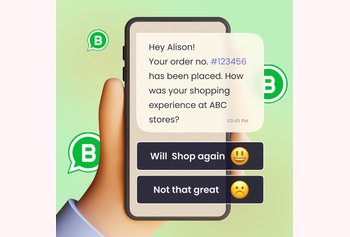25 Essential Empathy Statements to Transform Your Customer Service Experience

Table of contents
Let’s say you ordered a product for a special occasion. It turns out to be defective. The next thing you do is call the customer service representative.
Imagine the representative bluntly telling you they can’t do anything about it. Would you still continue doing business with them? Probably not. And you’re not the only one. A survey of 2000 consumers reveals that 86% of consumers will leave a brand they trust after two poor experiences.
Now flip this scenario. What if the customer service representative apologized, understood your anger, and took steps to ensure a new product gets delivered to you as soon as possible? Wouldn’t you buy from this company again? You probably would!
That’s how using empathy statements in customer serviceinteractions can make all the difference. It shows the customers that you are on their side and will take personal responsibility for resolving their issues.
In this article, we’ll discuss common customer service scenarios and essential empathy statements you can use for each.
Table of Contents
- Key Elements of Effective Empathy Statements
- 25 Powerful Empathy Statements for Various Scenarios
- Empathy statements to start customer service interactions
- Empathy statements for dealing with frustrated customers
- Empathy statements for handling technical issues
- Empathy statements for addressing billing concerns
- Empathy statements for managing delivery delays
- Empathy statements for addressing rush issues
- Empathy statements for closing a conversation
- Cultural Considerations in Empathy Statements
- AI and Empathy: Finding the Right Balance
Key Elements of Effective Empathy Statements
Every empathy statement holds a few common elements. Here are five of them you can use to test if your empathy statements are actually impactful.
- Recognize and validate emotions: Let the customer know you understand what they are going through. For example, use phrases like, “Your frustration is completely justified.”
- Show you’re actively listening: Listen to the customer without interrupting them. Rehash key details by saying, “Just to confirm….”
- Genuinely apologize: In scenarios where your company is in the wrong, ensure you apologize. For example, you could say something like, “I apologize, Susan. This can be frustrating. Let me help you fix it right away.”
- Provide reassurance: Build trust by showing customers their problems will be resolved. For example, “I will work with you to resolve this problem.”
- Providing personalized responses: Use ‘I’ and ‘you’ in your statements to create a personal connection. You can even ask to use their name to humanize the conversation. For example, “Hi, Mr. Alan Brickett, I am Sam. Would you mind if I refer to you as Alan?”
25 Powerful Empathy Statements for Various Scenarios
In a conversation with Hiver, Greg Melia, CEO of the Customer Experience Professionals Association (CXPA),said, “Empathy can be designed and taught. So, as an organization, you want to ensure you are teaching people to be better listeners. Better listening is a key customer service quality and skill.”
To know when to use the right empathy statements, you need to listen to the customers, put yourself in their shoes, and then use a combination of the statements given below. Note that these statements are great as a starting point, but you may want to adapt them to suit your company’s tone, values, and customer preferences.
Empathy statements to start customer service interactions
First impressions matter, especially in customer service. When a customer reaches out to you, how you start the conversation sets the tone and dictates how things move forward.
This is what psychologists call the ‘halo effect.’ It’s a cognitive bias in which an overall impression of a person, product, or brand is based on a single characteristic or behavior—in this case, the first impression.
Below are a few statements you can start with.
#1. “Hi, Susan! This is Paul. I will assist you with your problem and ensure it gets solved smoothly.”
#2. “Good afternoon, Lucy! Thanks for reaching out. I understand how important this issue is, and I am here to help.”
#3. “Thanks for reaching out to us. Let’s work together to find a solution to your issue.”
Pro-tip: Use the customer’s name when you greet them. This makes the conversation feel less robotic.
Empathy statements for dealing with frustrated customers
Sometimes, customers will be in a foul mood because of some issue that they are facing. This is where using empathy statements can help defuse the situation.
One way is to let them know how frustrated you’d be if you were in the same situation. This plays on the ‘Similar to me’ cognitive effect. This is where we tend to side with people who think and look like us.
For example, when an irate customer reaches out with ordering issues, saying “Calm down” would not work as well as saying, “I went through the same situation a week back, and I can totally understand why this might be frustrating for you.”
Validating their emotions in this way can help diffuse their anger. Here are some statements you can use.
#4. “I am sorry you had to deal with this. Thankfully, there’s a quick solution. Let’s go over it step-by-step.”
#5. “You are totally right. We should have done [XYZ]. I’ll make sure to speak with the team and get this issue resolved.”
#6. “I experienced a similar problem recently, so I understand what you’re going through. Let me help you out.”
#7. “I know this is super frustrating. My team is working on this right now. I’ll have an answer for you in a few minutes.”
Empathy statements for handling technical issues
When a customer reaches out with a technical issue, it’s important that you’re extremely clear yet empathetic in what you’re saying.
To ensure you provide the right solution, repeat or paraphrase the problem back to them. Once they confirm, offer a list of recommended solutions.
You can use statements like:
#8. “I am sorry you’re encountering this technical issue. I know how disruptive it can be, and I am here to troubleshoot it with you. Let’s go through it step-by-step.”
#9. “Don’t worry, I have solved this problem before. Let me walk you through the steps.”
#10. “I can see you’ve already tried certain steps to fix the issue on your own. I appreciate your effort and now I’ll take it from here to find you a solution.”
#11. “I know this error is holding things up for you. But I am prioritizing your issue to get a swift resolution.”
Pro-tip: Encourage your reps to talk about their expertise while dealing with a technical issue. This helps the customer trust your representative more.
Empathy statements for addressing billing concerns
Billing issues can make customers feel anxious as they often involve personal finances. Some of these issues could be failed payments, unexpected charges, or no-payment confirmations.
While these issues may seem minor, customers may need you to resolve them quickly so they can move on to other important tasks.
Below are some empathy statements you can use to de-escalate heightened emotions when faced with billing concerns.
#12. “I apologize for the billing discrepancy you encountered. Let’s work through the details to resolve this issue.”
#13. “You’re right. There’s an unexpected charge on your bill. I’ll do my best to investigate what this charge is about and get it fixed for you.”
#14. “I understand how important it is for billing to be accurate, especially when you’re handling your finances. Please give me a few minutes to get it sorted with the finance team.”
Empathy statements for managing delivery delays
21% of consumers lose trust in a brand after a delayed delivery. Most customers just switch to competitors. But if these customers are reaching out to your customer service team, they are giving you an opportunity to correct things.
By being empathetic and offering a fix, you can turn their experience around and ensure they stick with your company.
Here are some statements that you can use.
#15.“I know how disappointing it can be when you’re expecting a package and it does not arrive on time. I apologize for the delay.”
#16.“I am really sorry for the delay in this delivery. This isn’t a normal situation for us, and I appreciate your patience while I try to find the reason and expedite the delivery.”
#17. “Let me figure out what caused this delay and I’ll make sure it gets to you soon. Give me a few minutes.”
#18. “Let me check the information provided to me. I’ll also get in touch with the shipping department to see how we can speed up the delivery for you.”
Empathy statements for addressing rush issues
Many customers are in a rush to solve their problems. In these urgent situations, you may have to balance empathy with a touch of calmness.
Try out one of the below phrases.
#19. “I understand you want to get this issue resolved quickly. Let’s work together to get this sorted out fast”
#20. “I know you’re pressed for time. I’ll do everything I can to expedite this for you.”
#21. “I am sorry that this is taking so long. I want to make sure we get it fixed today.”
#22. “I have got our team working on this right now. I assure you we will have an answer in the next few minutes.”
Empathy statements for closing a conversation
After you have solved the customer’s problem, you should close the conversation on a quick but empathetic note. Some examples:
#23. “I am glad I could solve this problem for you. Have a wonderful day ahead.”
#24. “Thank you for reaching out. Is there anything else I can help you with before I end the call?”
#25. “I appreciate your patience. I’ll pass this message on to the team to avoid such issues in the future.”
Cultural Considerations in Empathy Statements
Your customers come from diverse backgrounds and cultures. To ensure your message is portrayed in the right manner, here are four cultural considerations.
- Tone: Different cultures interpret tones differently. For example, in Western cultures, a more casual/friendly tone would work. In formal cultures, stick to a formal and respectful approach.
- Emotions/expressions: Not every culture prefers open expression of emotions. For example, in Latin America, being highly expressive may be seen as being empathetic. In Scandinavian culture, however, a measured approach may be preferred.
- Language: When communicating with non-native speakers, use plain, simple language. Avoid using idioms and complex statements to reduce misunderstandings.
AI and Empathy: Finding the Right Balance
Empathy in customer service benefits everyone – your customers feel heard and understood, your support team feels good about their work, and it improves your business metrics.
Greg Melia mentioned in our podcast, “One of the big things people want is reliability. Yourcustomers should be assured they can go up to you and get a quality experience at the right time at the right price. Part of customer experience is making sure this happens again and again.”
To ensure reliability, you might need to automate certain parts of your customer service operations. For instance, how do you offer 24/7 support? A simple solution here would be to invest in an AI chatbot.
Customers would then see you as a brand they can rely on, no matter when or where they have a question. You can even train the chatbot to send empathetic and tailor-made responses.
But do keep in mind that AI or automation can’t replace the human touch, for now. You’d need to be smart about where to leverage AI and where to use human intervention on customer issues.
Try using Hiver’s AI bot for free.

































